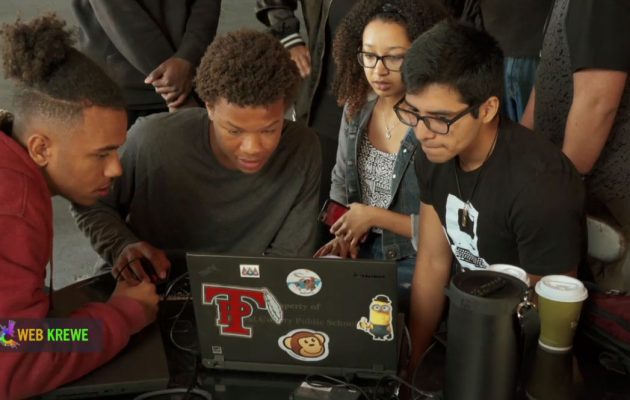Creative incubator warms students up to career in programming

Students from low-performing high schools had a chance to shine last school year when they were immersed in a technological challenge that allowed them to gain real world experiences in complex problem solving, gathering and evaluating evidence, and deciphering information – skills that students learn by studying science, technology, engineering, and math – subjects collectively known as STEM.
They did so by learning every facet of website development and completing projects for real clients.
The idea for the initiative – known as Web Krewe – was conceived when Kevin Calloway of IJHANA, a global technology consulting firm, was watching a Girl Scout troop doing robotics with Renaissance Jax and struck up a conversation with someone from STEM HUB2, an organization that seeks to increase student interest, preparation, and attainment in STEM for success in related degrees and careers.
“We were waiting for the Girl Scouts to finish and they started talking to me about an idea, which was to teach kids how to program in high school. I kind of went down the path of what I would do to hire kids. A certificate in a programming language doesn’t offer them anything else; it’s not marketable and doesn’t get them a job,” said Calloway. “So the question became, ‘How do you take kids who are in underperforming schools in neighborhoods where it is easy to get stuck and how do you motivate them and give them an opportunity to better their situation – not just help them get another certificate that is not useful?’”
The program, which is 100 percent funded by IJHANA, began in October 2017 when the opportunity was opened to students from underserved high schools in Duval and surrounding counties. Teams were made up of eight to 12 students in grades nine through 12, and the only requirement was an interest in technology, including graphic design, coding and the business aspects of information technology.
Each team was composed of a teacher and an industry mentor. According to Calloway, those involved with establishing the program were fortunate enough to be able to call in all of their friends, who came and helped them out; they all had affinities for the schools that were involved.
“Everybody had amazing mentors,” he said. “In the second half of the program, the mentors are what really make this. We had experts there to show the students how to write a business plan or approach a client. We taught them not only the fun side, but also the business side.”
During the first half of the program, the students, whether interested in project management, graphic design, sales or engineering, learned the basics of programming – the idea being that when working on projects, programmers have a better idea of how to price and manage such projects. Once they had the basics under their belts, the teams worked together to go find clients in the real world, pitch them a project and complete that project for them. The program culminated in the teams doing a presentation at Museum of Science and History (MOSH) where CEOs from all over Jacksonville were present, and the clients saw their completed projects for the first time. Clients included a private chef, a gaming company and Putnam County, just to name a few.
“We put the students through some things that were rather difficult, but they didn’t bat an eye,” Calloway said. “Every single team found their own client, learned what their client wanted and learned about their client’s business. They had to work closely together as a team throughout the project, and they had to get up and speak in front of a group of CEOs.”
Students were also exposed to other elements they had never experienced. Throughout the program there were five competitions during which 60-80 kids showed up at Space 42 – a 22,000-square-foot warehouse in Riverside that houses IJHANA and an art gallery. Competition topics included Java, HTML and other web-related subjects. The winners were selected by board members consisting of C-level executives from various companies around the city.
“We ended every competition with a tour of the art gallery. The artist whose work was on display would give these kids an in-depth tour, spending about 30 to 45 minutes with them,” said Calloway. “Rather than ordering pizza for the kids, we wanted to give them something they’d never experienced before, so we had a chef come in and prepare some cuisine for them.”
Last year was such a success that the program has expanded this year to include a wider range of high schools, not just those that are underserved.
“What we learned last year was we were able to reach people who wouldn’t have done this if it were just for programmers. The students had life-changing moments because they learned about a career they didn’t know existed. It takes a team of multi-talents to actually make that happen. It’s not based on race, gender or age – it’s based on willingness to learn and be a part of that team,” Calloway said.
“The whole goal was to get them jobs. We had a lot of success with that – 26 of the students got internships,” said Calloway. “It’s probably one of the most amazing things I’ve done in my life.”
By Kandace Lankford
Resident Community News






